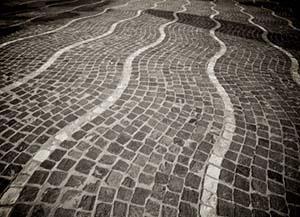PROGETTO LIKE A ROLLING STONE
IL BASALTO
How is a basaltic lava formed?
The sudden decrease in pressure, when passing outside the earth's crust, causes
degassing of the magma: the gases, initially dissolved in solution, undergo a sudden
evaporation, separating from the magmatic melt which, consequently to the variation of
the chemical composition, is transformed into lava. The gases released by the degassing
process are water vapor (which generates juvenile water), CO2, CO, SO2, SO3, Cl2, N2
and the rare elements.
Basaltic lavas can, by solidifying, lead to multiple structures depending on the speed
with which they cool and the characteristics of the environment.
Lava has a temperature ranging from 600-1400 ° C. Although it is quite viscous, up to
100,000 times the viscosity of water depending on the composition, it can flow over
large distances before cooling and solidifying, depending on its properties.
When the lava solidifies, it forms
effusive igneous rocks.
Basalt is an effusive rock of volcanic origin, dark or black in color with a relatively low silica content.
Basalt can have an appearance ranging from porphyritic to microcrystalline to glassy.
In this case the basalt has a porphyric aspect.
The rock has a vesicular texture: the rock contains small cavities (vesicles) generated by the gas bubbles contained in the magma.
Typical of pumice and acidic effusive rocks, with more viscous lava which therefore more easily traps gases during cooling.
Roccia Dullia
by Edodullia
on Sketchfab
IMPIEGO NELLE COSTRUZIONI
Questa pietra lavica offre eccellenti proprietà fisico meccaniche e può essere tranquillamente
utilizzata per le pavimentazioni esterne e rivestimenti, mentre per i pavimenti interni se
ne consiglia la lucidatura. Il suo colore scuro trova impiego in molte costruzioni contemporanee
dove vengono impiegate piastrelle e lastre in misura fissa. Il basalto può essere lavorato
in superficie e tende a diventare leggermente chiaro. Le sue ottime caratteristiche di
resistenza al gelo consigliano questa roccia anche in ambienti umidi e
freddi. Un magnifico esempio è la pavimentazione di piazza san Pietro a Roma, ricoperta
di sanpietrini, mattonelle di basalto tipiche della architettura romana sin dall’impero.

